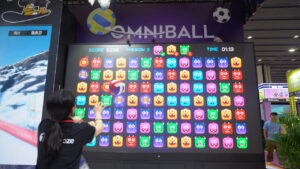In today’s rapidly evolving educational landscape, technology plays a pivotal role. Immersive kindergarten digital education projection technology, combining interactive sensory tools with innovative programs, is setting new standards. But what exactly is this technology, and how does it revolutionize learning for young children?
Creative Learning Experiences for Immersive Kindergarten Projection
When we talk about creative learning experiences in an immersive kindergarten, we envision a classroom where children interact with digital projections on the walls and floors. These interactive projections respond to their movements, creating a dynamic learning environment. Such experiences are not only engaging but also cater to various learning styles.
- Enhancing Cognitive Skills: Immersive projection technology helps in developing cognitive skills by presenting information in a multisensory manner. For instance, children can learn numbers and alphabets through interactive games projected on the floor.
- Fostering Creativity: These digital tools allow children to express themselves creatively. They can paint, draw, and create stories within an interactive setting, making learning fun and memorable.
Digital Kindergarten with Immersive Wall Projector
Integrating wall projectors in kindergartens is a game-changer. These digital projectors transform ordinary classrooms into vibrant, interactive learning spaces.
- Interactive Lessons: Teachers can project interactive lessons that children can manipulate. This hands-on approach makes abstract concepts tangible and easier to understand.
- Real-time Feedback: One of the significant advantages is real-time feedback. Children receive immediate responses to their actions, helping them understand cause and effect.

Immersive School Interactive Projection for Kids
Immersive school interactive projection systems are not just limited to kindergartens. They have potential applications across various educational levels. However, their impact is most profound in early childhood education.
- Engaging All Senses: These systems engage multiple senses, making learning more effective. Children can see, touch, and even hear the content, which enhances retention and understanding.
- Collaboration and Social Skills: Interactive projections often require children to work together, fostering collaboration and social skills. They learn to share, take turns, and communicate effectively.

Immersive Kindergarten Programs with Wall Projector Systems
Implementing immersive kindergarten programs with wall projector systems requires thoughtful planning and execution. Schools must collaborate with suppliers and manufacturers to choose the best systems tailored to their needs.
- Selecting the Right System: Factors such as price, software capabilities, and supplier reliability are crucial. Schools should aim to order systems from reputable manufacturers known for quality and durability.
- Training Educators: Educators need proper training to maximize the potential of these technologies. Understanding how to integrate digital projections into their teaching methods is essential for success.
Interactive Sensory Technology and Education
Interactive sensory technology goes beyond just visual projections. It includes tactile feedback, sound effects, and sometimes even olfactory stimuli. This multi-sensory approach is particularly beneficial for young learners.
- Inclusive Learning Environment: By addressing different sensory modalities, this technology ensures that all children, regardless of their learning preferences, have equal opportunities to succeed.

Future Trends in Immersive Education Technology
The future of immersive education technology looks promising, with continuous advancements and innovations on the horizon.
- Augmented and Virtual Reality: Augmented Reality (AR) and Virtual Reality (VR) are set to become integral parts of immersive learning. These technologies will provide even more engaging and interactive experiences.
- AI Integration: Artificial Intelligence (AI) can personalize learning experiences, adapting to each child’s progress and needs, ensuring optimal learning outcomes.
Immersive projection technology enhances engagement, supports various learning styles, fosters creativity, and develops social skills through interactive and multisensory experiences.
Schools should consider factors such as system capabilities, price, software compatibility, and supplier reputation. Collaborating with experienced manufacturers and seeking educator input is also essential.
Educators need training on integrating digital projections into their teaching methods, understanding the technology’s capabilities, and creating interactive lessons that maximize student engagement.














